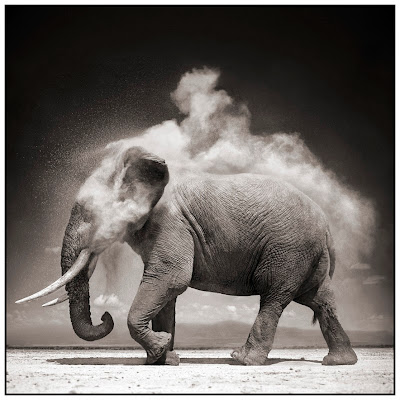 |
| Elephant with Exploding Dust. Photo: © Nick Brandt Source: http://www.younggalleryphoto.com/photography/nickbrandt/nb.html |
If you've ever done an online search for elephant images, you've probably come across Nick Brandt's work.
Although the images are stunning on their own, Brandt's work is particularly moving for what it says about our vanishing natural world. Speaking about his decision to work only in black-and-white, Brandt has said, "Colour has a very modern feel on the whole, and since my feeling is that many of these animals will soon be gone, and are therefore from a bygone era, the black-and-white aesthetic further heightens that impression."
 |
| Elephant Skull Photo: © Nick Brandt Source: http://www.younggalleryphoto.com/photography/nickbrandt/nb.html |
Born and raised in London, England, Brandt studied painting, then film. Moving to California in the early 1990s, he directed a number of award-winning music videos for artists such as XTC, Moby, Jewel and Michael Jackson. It was actually while directing a video for Jackson's "Earth Song" in 1995 that Brandt first fell in love with East Africa and its wildlife.
In 2000, Brandt began turning his attention away from film and towards photography, taking the first photographs in what would become a trilogy of books—On This Earth (2005), A Shadow Falls (2009) and Across the Ravaged Land (2013)—that capture a rapidly disappearing world.
 |
| Calcified Bat II Photo: © Nick Brandt Source: http://www.younggalleryphoto.com/photography/nickbrandt/nb.html |
Brandt shoots his images in medium-format on film—a photographer after my own heart—then scans the negatives. Although he plays with contrast and light values after the fact, the images themselves are essentially as he captured them in the wild.
He also doesn't use long lenses, as many wildlife photographers do; nor does he tend to go for action shots. For me, part of what is so unique and compelling about his work is the sense of personal encounter—as if he'd asked the animals to pose, and they'd politely agreed.
 |
| Elephant on Bare Earth Photo: © Nick Brandt Source: http://www.younggalleryphoto.com/photography/nickbrandt/nb.html |
In the afterword to his book, On This Earth, Brandt wrote, "What I am interested in is showing the animals simply in the state of Being. . . . To me, every creature, human or non-human, has an equal right to live, and this feeling, this belief that every animal and I are equal, affects me every time I frame an animal in my camera. The photos are my elegy to these beautiful creatures, to this wrenchingly beautiful world that is steadily, tragically vanishing before our eyes."
 |
| Buffalo with Lowered Head Photo: © Nick Brandt Source: http://www.younggalleryphoto.com/photography/nickbrandt/nb.html |
In addition to his work as a photographer, in 2010 Brandt started the Big Life Foundation, which works primarily to reduce poaching in East Africa. Some of his most powerful photographs feature Foundation rangers holding the tusks of elephants killed prior to the Foundation's inception.
 |
| Ranger with Tusks of Killed Elephant Photo: © Nick Brandt Source: http://www.younggalleryphoto.com/photography/nickbrandt/nb.html |
Since 2004, Brandt has been featured in exhibitions from Sydney to Los Angeles, and his photographs are found in numerous galleries, museums and private collections around the world. To see more of his work, click here.
 |
| Elephant with Tattered Ears Photo: © Nick Brandt Source: http://www.younggalleryphoto.com/photography/nickbrandt/nb.html |
Elephant Lore of the Day
Earlier this year, poachers killed hundreds of elephants in Zimbabwe by lacing salt pans with cyanide, right near water holes. Elephants need significant quantities of both salt and water to survive, making this a particularly cruel trick.Despite their size, elephants are just as susceptible to poison as other creatures, and cyanide results in an agonizing death. As if this weren't bad enough, carrion-eaters such as lions, hyenas and vultures fed on the elephant corpses, and also died. The water holes also became contaminated as the poisonous salt washed into it, killing many other animals such as antelope and water buffalo.
The elephants died only a few yards from the poisoned sources in numbers so great that one witness said, "We couldn't believe what we were seeing. At first we thought they were shot, because there were so many. Then we saw that their tusks were gone." In these days of mechanized poaching sprees, I find it especially depressing that a man's first thought was that such large numbers of dead elephants could only mean mass shooting.
Zimbabwe has one of the world's largest African elephant populations, with an estimated 80,000—half of which live in Hwange National Park, where the killings occurred. For the most part, they've been fairly well protected. In recent years, however, destitute locals have taken to poaching in a big way, knowing they can sell a single tusk for upwards of $500—which will sell in South Africa for as much as $5,000 or more.
The killings are thought to have taken place primarily in July of this year, when the national park's security forces—which normally protect the herds—were temporarily reassigned to cover the national election and its aftermath.
Fourteen people have been arrested in connection with the poisonings, including local poachers and a South African businessman. According to some of the poachers, the businessman used an ivory buyer and a Zimbabwean farmer to distribute the cyanide to locals.
Vowing a massive crackdown on poaching in the wake of this incident, Zimbabwe's environment minister said that the penalties must be increased. At present, killing an elephant in Zimbabwe results in a lesser punishment than cattle rustling. To read more, click here.
 |
| One of Zimbabwe's embattled herds. Photo: Jim Zuckerman/Corbis Source: http://www.dailymail.co.uk/news/article-2470219/Elephants-graveyard- 300-animals-poisoned-poachers.html |
To Support Elephant Welfare
Boon Lott's Elephant Sanctuary (Thailand)Wildlife SOS (India)
The Elephant Sanctuary (Tennessee)
David Shepherd Wildlife Foundation
Big Life Foundation

No comments:
Post a Comment